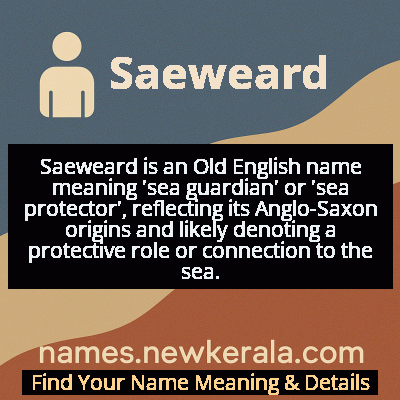Saeweard Name Meaning & Details
Origin, Popularity, Numerology Analysis & Name Meaning of Saeweard
Discover the origin, meaning, and cultural significance of the name SAEWEARD. Delve into its historical roots and explore the lasting impact it has had on communities and traditions.
Name
Saeweard
Gender
Male
Origin
Christian
Lucky Number
4
Meaning of the Name - Saeweard
Saeweard is an Old English name meaning 'sea guardian' or 'sea protector', reflecting its Anglo-Saxon origins and likely denoting a protective role or connection to the sea.
Saeweard - Complete Numerology Analysis
Your Numerology Number
Based on Pythagorean Numerology System
Ruling Planet
Uranus (Rahu)
Positive Nature
Strong sense of order, loyal, practical, and disciplined.
Negative Traits
Stubborn, overly serious, rigid, and prone to feeling restricted.
Lucky Colours
Blue, gray.
Lucky Days
Saturday.
Lucky Stones
Blue sapphire.
Harmony Numbers
1, 7, 8.
Best Suited Professions
Managers, engineers, accountants, organizers.
What People Like About You
Dependability, discipline, practicality.
Famous People Named Saeweard
Saeweard of Kent
Anglo-Saxon noble
Co-ruler of Kent alongside his brothers Eadbald and Eormenred, mentioned in Bede's Ecclesiastical History
Saeweard of Mercia
Anglo-Saxon noble
Member of the Mercian royal family during the reign of King Æthelbald
Saeweard of Wessex
Anglo-Saxon thegn
Recorded in the Anglo-Saxon Chronicle as a prominent landowner and military leader
Name Variations & International Equivalents
Click on blue names to explore their detailed meanings. Gray names with will be available soon.
Cultural & Historical Significance
The name's appearance in multiple Anglo-Saxon kingdoms (Kent, Mercia, Wessex) demonstrates its widespread appeal across different regional cultures within England. Each documented Saeweard in historical records represents a specific moment in England's development—from the early Christianization in Kent to the consolidated kingdoms facing Viking threats. The name gradually fell out of use after the Norman Conquest, as French names replaced traditional English ones among the nobility, though it persisted in some forms. Its legacy survives in place names and the modern variant 'Seward,' while the original form remains a valuable artifact for understanding Anglo-Saxon social structures, military organization, and the intersection of pagan and Christian traditions in early English history.
Extended Personality Analysis
Individuals bearing the name Saeweard are typically characterized by a profound sense of responsibility and protective instinct that manifests in both personal and professional contexts. Their personality combines the depth and adaptability of water with the steadfast reliability of earth, creating individuals who can navigate complex emotional landscapes while maintaining strong moral boundaries. Saeweards often exhibit natural leadership qualities, though they tend to lead through quiet competence rather than charismatic dominance. They are strategic thinkers who approach problems with the careful consideration of a naval commander plotting a course through unknown waters, weighing risks and opportunities with remarkable balance. Their protective nature extends beyond physical safety to emotional well-being, making them exceptionally loyal friends and partners who remember obligations and honor commitments long after others might forget.
In social settings, Saeweards may initially appear reserved or contemplative, but this reflects their tendency to observe and understand situations thoroughly before engaging. Once they commit to relationships or causes, they demonstrate unwavering dedication and surprising emotional depth beneath their calm exterior. They thrive in roles that allow them to protect, guide, or preserve—whether as parents, mentors, conservationists, or leaders in fields requiring long-term strategic thinking. Their connection to the sea element in their name often translates to comfort with change and adaptability to new circumstances, though they always maintain core principles that anchor their identity. Potential challenges for Saeweards include tendencies toward overprotectiveness or difficulty delegating responsibility, as their guardian instinct can sometimes manifest as controlling behavior when they feel their protective role is threatened.
Modern Usage & Popularity
In contemporary naming practices, Saeweard exists as an extreme rarity, primarily preserved within specific communities with strong interests in Anglo-Saxon heritage, historical reenactment groups, and academic circles studying medieval history. The modern simplified form 'Seward' sees occasional use, particularly in English-speaking countries with historical connections to Britain, though it remains uncommon in birth statistics. The name experienced a minor revival during the 19th century when Victorian England developed a fascination with medieval history and Arthurian legends, but this resurgence was limited. Today, the name is occasionally chosen by parents seeking unique historical names with strong, meaningful roots, though it doesn't register in official baby name rankings. Its usage is mostly confined to families preserving specific cultural traditions, historical fiction enthusiasts, and occasionally as a middle name honoring ancestral connections. The name's complexity and unfamiliar spelling to modern eyes present barriers to widespread adoption, ensuring it remains a distinctive choice for those specifically seeking Anglo-Saxon names with authentic historical resonance and powerful protective symbolism.
Symbolic & Spiritual Meanings
Symbolically, Saeweard represents the powerful convergence of fluidity and stability—the ever-changing, mysterious sea meeting the steadfast, reliable guardian. This combination creates rich metaphorical meaning around the concept of 'liminal guardianship,' protecting the threshold between known and unknown realms. The sea element symbolizes depth of emotion, intuition, the unconscious mind, and the flow of life's experiences, while the guardian aspect represents protection, boundaries, moral fortitude, and conscious responsibility. Together, they suggest an individual capable of navigating life's emotional currents and uncertainties while maintaining strong principles and protective instincts. In psychological terms, this symbolizes the ego's crucial role in protecting the self while exploring the depths of the unconscious—a balance between adventure and security, exploration and preservation. The name also carries environmental symbolism, representing humanity's relationship with the natural world as both explorers of its mysteries and guardians of its preservation. This dual symbolism makes Saeweard a powerful representation of balanced leadership—the ability to adapt to changing circumstances while protecting core values and those under one's care.

